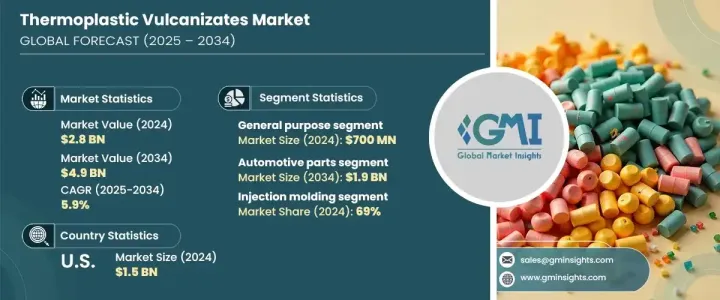
|
시장보고서
상품코드
1684691
열가소성 가황물(TPV) 시장 기회, 성장 촉진 요인, 산업 동향 분석, 예측(2025-2034년)Thermoplastic Vulcanizates Market Opportunity, Growth Drivers, Industry Trend Analysis, and Forecast 2025 - 2034 |
||||||
열가소성 가황물(TPV) 세계 시장은 2024년에 28억 달러에 이르렀고, 2025년부터 2034년에 걸쳐 CAGR은 5.9%를 나타낼 것으로 예측됩니다.
열가소성 엘라스토머(TPE) 중에서도 특수한 카테고리인 TPV는 고무와 같은 우수한 유연성과 열가소성 수지의 가공의 용이성을 겸비하고 있기 때문에 인기를 끌고 있습니다. 자동차, 헬스케어, 소비재 등 업계에서는 내구성, 비용효과, 내마모성, 내약품성, 극단적인 온도에 대한 뛰어난 내성을 이유로 TPV의 채용이 증가하고 있습니다. 지속가능성과 규제 준수에 대한 관심 증가는 시장 수요를 더욱 촉진하고 있으며, 제조업체는 경량 재활용 가능한 재료를 선호합니다. 엄격한 환경 정책이 시행되는 동안 TPV는 기존의 고무 및 기타 엘라스토머를 대체하고 성능을 저하시키지 않고 환경 친화적인 대안을 제공합니다.

재료공학과 가공기술의 진보가 시장 확대에 중요한 역할을 하고 있습니다. 의료기기, 실외 용도 및 난연성 솔루션에 대한 TPV 수요는 업계가 안전 및 규정 준수 기준을 충족하는 고성능 대체품을 요구함에 따라 증가하고 있습니다. 전기자동차(EV)와 에너지 효율이 높은 부품을 중시하는 경향이 강해지고 있는 것도, 자동차 용도로의 TPV의 채용을 뒷받침하고 있습니다. 기업이 제품의 수명을 연장하고 재료 낭비를 줄이기 위해 노력하고 있기 때문에 차세대 제조 솔루션에 대한 TPV 통합이 확산되고 있습니다. 또한 세계 인프라와 건설 활동이 확대됨에 따라 실링 시스템, 지붕 막 및 산업 부품에 TPV 기반 용도의 추가 기회가 탄생했습니다. 세계 TPV의 상황은 계속 진화하고 있으며, 각 회사는 다양한 최종 사용자의 요구에 부응하는 혁신적인 배합을 개발하기 위해 연구 개발에 투자하고 있습니다.
| 시장 범위 | |
|---|---|
| 시작 연도 | 2024년 |
| 예측 연도 | 2025-2034년 |
| 시작 금액 | 28억 달러 |
| 예측 금액 | 49억 달러 |
| CAGR | 5.9% |
범용 TPV 분야는 2024년에 7억 달러에 이르렀고, 2034년까지 연평균 복합 성장률(CAGR) 6.1%로 성장할 것으로 예상됩니다. 자동차, 산업, 소비자 응용 분야에서의 범용성은 이 분야를 중요한 시장 성장 촉진요인으로 자리잡고 있습니다. 의료 등급 TPV는 생체적합성과 엄격한 규제 기준에의 적합성으로 인해 수요가 급증하고 있어 건강 관리 용도에 최적입니다. 또한 UV 안정성과 난연성을 갖춘 TPV는 옥외 환경과 안전성이 중시되는 분야에서 채용이 증가하고 있습니다. 이러한 특수 등급은 뛰어난 내구성과 성능을 제공하며 업계 특유의 과제를 해결하여 시장에서 발판을 굳히고 있습니다.
사출 성형은 여전히 지배적인 제조 기술이며 2024년 시장 점유율은 69%, 평가액은 19억 달러입니다. 그 정밀도, 효율성, 복잡한 디자인을 대규모로 생산하는 능력으로 TPV 생산에 적합한 옵션이 되고 있습니다. 경량 소재와 비용 효율적인 생산 공정을 요구하는 움직임이 채용률의 상승으로 이어지고 있습니다. 반응 압출 및 기타 틈새 제조 기술은 특정 용도에 해당하지만 시장에서의 존재는 여전히 제한적입니다. 기계 및 자동화의 지속적인 발전으로 사출 성형 공정이 더욱 최적화되어 제조업체는 낭비와 운영 비용을 최소화하면서 고품질 생산량을 달성할 수 있습니다.
미국의 열가소성 가황물(TPV) 시장은 자동차, 건설, 산업 부문의 왕성한 수요에 견인되었으며, 2024년에는 15억 달러를 창출했습니다. 산업계의 경량·고성능 소재로의 시프트가 진행됨에 따라 2034년까지 이 시장은 26억 달러에 달할 것으로 예측됩니다. 제조의 진보는 주요 최종 사용자 산업의 확대와 함께 미국을 TPV 기술 혁신의 리더로 자리매김하고 있습니다. 미국은 기술 진보의 최전선에 계속해서 새로운 용도를 육성하고, 여러 섹터에 걸친 성장 기회를 끌어내고 있습니다.
목차
제1장 조사 방법과 조사 범위
- 시장 범위와 정의
- 기본 추정과 계산
- 예측 계산
- 데이터 소스
- 1차 데이터
- 2차 데이터
- 유료 정보원
- 공적 정보원
제2장 주요 요약
제3장 업계 인사이트
- 생태계 분석
- 밸류체인에 영향을 주는 요인
- 이익률 분석
- 파괴
- 장래의 전망
- 제조업체
- 유통업체
- 공급자의 상황
- 이익률 분석
- 주요 뉴스
- 규제 상황
- 영향요인
- 성장 촉진요인
- 지속 가능하고 친환경 소재에 대한 수요 증가
- 자동차 및 의료 분야에서의 용도 확대
- 재료 기술과 제품 혁신의 발전
- 업계의 잠재적 위험 및 과제
- 높은 생산 비용과 원료 가격의 변동
- 규제상의 제약과 컴플라이언스 요건
- 성장 촉진요인
- 성장 가능성 분석
- Porter's Five Forces 분석
- PESTEL 분석
제4장 경쟁 구도
- 소개
- 기업 점유율 분석
- 경쟁 포지셔닝 매트릭스
- 전략 전망 매트릭스
제5장 시장 규모와 예측 : 그레이드별, 2021년-2034년
- 주요 동향
- 범용
- 의료용
- UV 안정 등급
- 난연 등급
- 접착 TPV
- 윤활 TPV
- 기타
제6장 시장 규모와 예측 : 가공방법별, 2021년-2034년
- 주요 동향
- 사출 성형
- 반응 압출 성형
- 기타
제7장 시장 규모와 예측 : 용도별, 2021년-2034년
- 주요 동향
- 자동차 부품
- 소비자용 제품
- 건축재료
- 산업용도
- 전선 및 케이블
- 의료기기
- 기타
제8장 시장 규모와 예측 : 지역별, 2021년-2034년
- 주요 동향
- 북미
- 미국
- 캐나다
- 유럽
- 영국
- 독일
- 프랑스
- 이탈리아
- 스페인
- 러시아
- 아시아태평양
- 중국
- 인도
- 일본
- 한국
- 호주
- 라틴아메리카
- 브라질
- 멕시코
- 중동 및 아프리카
- 남아프리카
- 사우디아라비아
- 아랍에미리트(UAE)
제9장 기업 프로파일
- Apar Industries
- Biesterfeld
- Bjørn Thorsen
- Celanese Corporation
- Elastron TPE
- FlexiShine Polyblends
- Kumho Polychem
- LCY
- Mitsubishi Chemical Group Corporation
- Mitsui Chemicals
- RTP
- SantopSeal
The Global Thermoplastic Vulcanizates Market reached USD 2.8 billion in 2024 and is projected to grow at a CAGR of 5.9% between 2025 and 2034. As a specialized category within thermoplastic elastomers (TPEs), TPVs are gaining traction due to their exceptional rubber-like flexibility combined with the ease of thermoplastic processing. Industries such as automotive, healthcare, and consumer goods are increasingly adopting these materials for their durability, cost-effectiveness, and superior resistance to wear, chemicals, and extreme temperatures. The rising focus on sustainability and regulatory compliance has further fueled market demand, with manufacturers prioritizing lightweight and recyclable materials. With stringent environmental policies in place, TPVs are replacing conventional rubber and other elastomers, offering an eco-friendly alternative without compromising performance.

Advancements in material engineering and processing technologies are playing a crucial role in market expansion. The demand for TPVs in medical devices, outdoor applications, and flame-retardant solutions is increasing as industries look for high-performance alternatives that meet safety and compliance standards. The growing emphasis on electric vehicles (EVs) and energy-efficient components is also driving the adoption of TPVs in automotive applications. As companies strive to enhance product longevity and reduce material waste, the integration of TPVs into next-generation manufacturing solutions is becoming more prevalent. Moreover, the expanding infrastructure and construction activities worldwide are creating additional opportunities for TPV-based applications in sealing systems, roofing membranes, and industrial components. The global TPV landscape continues to evolve, with companies investing in R&D to develop innovative formulations that cater to diverse end-user requirements.
| Market Scope | |
|---|---|
| Start Year | 2024 |
| Forecast Year | 2025-2034 |
| Start Value | $2.8 Billion |
| Forecast Value | $4.9 Billion |
| CAGR | 5.9% |
The general-purpose TPV segment reached USD 0.7 billion in 2024 and is set to grow at a CAGR of 6.1% through 2034. Its versatility in automotive, industrial, and consumer applications positions it as a significant market driver. Medical-grade TPVs are experiencing surging demand due to their biocompatibility and compliance with stringent regulatory standards, making them ideal for use in healthcare applications. Additionally, UV-stabilized and flame-retardant TPVs are witnessing increased adoption in outdoor environments and safety-critical sectors. These specialized grades offer superior durability and performance, addressing industry-specific challenges and strengthening their foothold in the market.
Injection molding remains the dominant manufacturing technique, holding a 69% market share in 2024 with a valuation of USD 1.9 billion. Its precision, efficiency, and ability to produce intricate designs at scale make it the preferred choice for TPV production. The push for lightweight materials and cost-effective production processes has led to higher adoption rates. While reactive extrusion and other niche manufacturing techniques cater to specific applications, their market presence remains limited. Continuous advancements in machinery and automation are further optimizing injection molding processes, allowing manufacturers to achieve high-quality output while minimizing waste and operational costs.
The United States thermoplastic vulcanizates market generated USD 1.5 billion in 2024, driven by strong demand from the automotive, construction, and industrial sectors. By 2034, the market is projected to reach USD 2.6 billion as industries increasingly shift toward lightweight, high-performance materials. Manufacturing advancements, coupled with the expansion of key end-user industries, continue to position the US as a leader in TPV innovation. The country remains at the forefront of technological progress, fostering new applications and unlocking growth opportunities across multiple sectors.
Table of Contents
Chapter 1 Methodology & Scope
- 1.1 Market scope & definition
- 1.2 Base estimates & calculations
- 1.3 Forecast calculation
- 1.4 Data sources
- 1.4.1 Primary
- 1.4.2 Secondary
- 1.4.2.1 Paid sources
- 1.4.2.2 Public sources
Chapter 2 Executive Summary
- 2.1 Industry synopsis, 2021-2034
Chapter 3 Industry Insights
- 3.1 Industry ecosystem analysis
- 3.1.1 Factor affecting the value chain
- 3.1.2 Profit margin analysis
- 3.1.3 Disruptions
- 3.1.4 Future outlook
- 3.1.5 Manufacturers
- 3.1.6 Distributors
- 3.2 Supplier landscape
- 3.3 Profit margin analysis
- 3.4 Key news & initiatives
- 3.5 Regulatory landscape
- 3.6 Impact forces
- 3.6.1 Growth drivers
- 3.6.1.1 Rising demand for sustainable and eco-friendly materials
- 3.6.1.2 Increasing applications in automotive and medical sectors
- 3.6.1.3 Advancements in material technology and product innovation
- 3.6.2 Industry pitfalls & challenges
- 3.6.2.1 High production costs and raw material price volatility
- 3.6.2.2 Regulatory restrictions and compliance requirements
- 3.6.1 Growth drivers
- 3.7 Growth potential analysis
- 3.8 Porter's analysis
- 3.9 PESTEL analysis
Chapter 4 Competitive Landscape, 2024
- 4.1 Introduction
- 4.2 Company market share analysis
- 4.3 Competitive positioning matrix
- 4.4 Strategic outlook matrix
Chapter 5 Market Size and Forecast, By Grade, 2021-2034 (USD Billion) (Kilo Tons)
- 5.1 Key trends
- 5.2 General purpose
- 5.3 Medical
- 5.4 UV stabilized grade
- 5.5 Flame retardant grade
- 5.6 Bonding TPV
- 5.7 Lubricated TPV
- 5.8 Others
Chapter 6 Market Size and Forecast, By Processing Method, 2021-2034 (USD Billion) (Kilo Tons)
- 6.1 Key trends
- 6.2 Injection molding
- 6.3 Reactive extrusion
- 6.4 Others
Chapter 7 Market Size and Forecast, By Application, 2021-2034 (USD Billion) (Kilo Tons)
- 7.1 Key trends
- 7.2 Automotive parts
- 7.3 Consumer products
- 7.4 Construction material
- 7.5 Industrial applications
- 7.6 Electrical Wire/cables
- 7.7 Medical devices
- 7.8 Others
Chapter 8 Market Size and Forecast, By Region, 2021-2034 (USD Billion) (Kilo Tons)
- 8.1 Key trends
- 8.2 North America
- 8.2.1 U.S.
- 8.2.2 Canada
- 8.3 Europe
- 8.3.1 UK
- 8.3.2 Germany
- 8.3.3 France
- 8.3.4 Italy
- 8.3.5 Spain
- 8.3.6 Russia
- 8.4 Asia Pacific
- 8.4.1 China
- 8.4.2 India
- 8.4.3 Japan
- 8.4.4 South Korea
- 8.4.5 Australia
- 8.5 Latin America
- 8.5.1 Brazil
- 8.5.2 Mexico
- 8.6 MEA
- 8.6.1 South Africa
- 8.6.2 Saudi Arabia
- 8.6.3 UAE
Chapter 9 Company Profiles
- 9.1 Apar Industries
- 9.2 Biesterfeld
- 9.3 Bjørn Thorsen
- 9.4 Celanese Corporation
- 9.5 Elastron TPE
- 9.6 FlexiShine Polyblends
- 9.7 Kumho Polychem
- 9.8 LCY
- 9.9 Mitsubishi Chemical Group Corporation
- 9.10 Mitsui Chemicals
- 9.11 RTP
- 9.12 SantopSeal



















